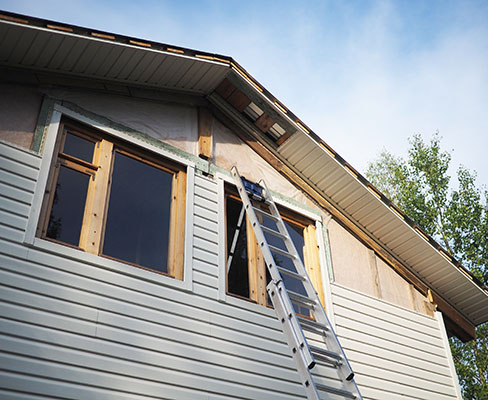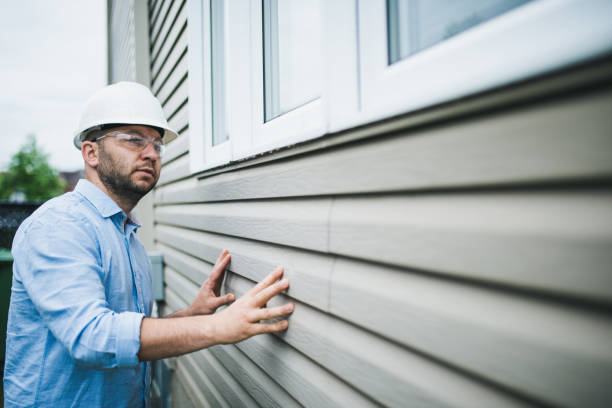The Vital Overview to the Various Sorts Of Exterior Siding and Their One-of-a-kind Advantages
In the realm of home enhancement, selecting the appropriate home siding is an important decision that impacts both aesthetic allure and useful efficiency. With so numerous choices to think about, which exterior siding material truly stands out for your specific task?
Wood Exterior Siding
Wood house siding, a preferred option for property exteriors, offers a classic visual that integrates natural elegance with architectural stability. This exterior siding product is available in numerous designs, consisting of clapboard, roof shingles, and board-and-batten, allowing property owners to customize their façade to match their design choices. Wood siding is generally crafted from sturdy types such as cedar, redwood, or yearn, which are known for their durability and ability to hold up against environmental stress factors.
Among the main advantages of wood house siding is its exceptional insulation buildings, which can add to power efficiency and reduced heating costs. Additionally, timber siding is naturally degradable, making it an environmentally pleasant alternative when sourced sustainably. Routine upkeep, including painting or discoloration, can lengthen its life expectancy and boost its appearance, enabling home owners to preserve the all-natural beauty of the wood.
Nevertheless, possible drawbacks include vulnerability to parasites, rot, and weather damage, demanding adequate treatment and maintenance - morris siding contractor. Despite these issues, when effectively cared for, wood house siding can provide a sturdy and gorgeous service that boosts the personality of a home while supplying a cozy, welcoming environment

Plastic Home Siding
Vinyl house siding has actually become a leading choice for home owners seeking a low-maintenance outside choice that combines durability and cost. This versatile product is crafted from polyvinyl chloride (PVC), making it resistant to different climate condition, consisting of wetness and UV rays. As an outcome, vinyl home siding does not warp, rot, or discolor, guaranteeing long-lasting aesthetic allure.
One of the main advantages of vinyl home siding is its extensive variety of styles and shades, permitting property owners to attain the desired look for their residential or commercial property without the requirement for constant repainting. Furthermore, vinyl exterior siding is very easy to mount, which can considerably lower labor expenses throughout building and construction or renovation jobs.
Plastic siding also contributes to energy effectiveness. Several options attribute insulation backing, which improves thermal performance, assisting to preserve comfy interior temperature levels and potentially reducing energy expenses. Its smooth surface helps with easy cleaning, requiring only periodic washing with a garden hose pipe to eliminate dirt and debris.
Fiber Cement Home Siding
Fiber cement siding has actually gained grip amongst house owners and building contractors alike because of its exceptional combination of sturdiness and aesthetic versatility. Made up of a combination of cellulose, cement, and sand fibers, this siding alternative is engineered to withstand extreme climate condition, consisting of high winds, heavy rainfall, and temperature fluctuations, making it a lasting choice for residential outsides.

Among the primary advantages of fiber concrete home siding is its resistance to parasites, such as termites, and its non-combustible nature, offering improved fire safety. morris siding contractor. Furthermore, it is available in a broad selection of appearances, styles, and shades, permitting home owners to achieve their preferred visual without compromising efficiency
Another advantage is its low upkeep requirements; fiber concrete siding normally calls for painting or staining every 5-10 years, which is less regular than other materials. Moreover, its long life adds to a lower general cost of ownership, as it minimizes the demand for constant repairs or replacements.
Ultimately, fiber cement house siding stands for an exceptional investment for those seeking a resilient, appealing, and functional outside alternative, incorporating both kind and feature to boost the home's aesthetic appeal.
Metal Exterior Siding
The appeal of steel house siding hinges on its robust durability and contemporary aesthetic appeal, making it a favored choice for contemporary style. Offered in products such as aluminum and steel, metal exterior siding provides a series of finishes and shades, permitting house owners to accomplish an individualized look that complements their layout vision.

Power effectiveness is an additional considerable benefit, as several steel house siding items are made with insulation options that help regulate interior temperature levels. This can cause lowered power expenses gradually. Furthermore, metal home siding is often recyclable, making it an environmentally friendly selection for sustainability-minded home owners.
The installment procedure for metal exterior siding can be fairly simple, causing a quicker turn-around time for building jobs. Overall, steel house siding combines functionality and style, making it a practical alternative for those looking for a visually appealing and enduring outside surface.
Brick and Rock Exterior Siding
Brick and rock exterior siding stands apart as an ageless option that enhances the visual appeal of any home. Recognized for their toughness and reduced maintenance, these materials offer an outstanding return on investment while elevating the home's curb charm. Available in different colors, structures, and patterns, block and rock can be customized this to suit varied building styles, from typical to contemporary.
Among the main benefits of brick and stone siding is their energy effectiveness. Both materials have all-natural insulating residential or commercial properties that assist manage indoor temperatures, potentially lowering heating and air conditioning prices. In addition, they offer remarkable fire resistance contrasted to various other siding options, contributing to boosted security.
One more advantage is their long life. Block and rock can last for years, often needing marginal maintenance past periodic cleansing. Unlike timber siding, they are impervious to insects and rot, my company making sure a durable outside that holds up against the components.
Verdict
In recap, the option of house siding significantly impacts a home's aesthetic appeal, energy performance, and upkeep needs. Each kind of home siding-- whether timber, plastic, fiber metal, brick, or concrete and stone-- offers special benefits tailored to different property owner choices and environmental conditions. Understanding these alternatives allows educated choices that boost both the longevity and aesthetic appeal of residential exteriors. Inevitably, selecting the right exterior siding is important for attaining an equilibrium between functionality and layout in property architecture.
One of the main advantages of wood house siding is its useful site exceptional insulation buildings, which can contribute to power efficiency and lower home heating costs. In addition, wood home siding is eco-friendly, making it an environmentally pleasant alternative when sourced sustainably.One of the primary benefits of steel siding is its resistance to different ecological factors.Energy effectiveness is an additional significant advantage, as several steel exterior siding items are made with insulation options that help control interior temperature levels. Each kind of siding-- whether timber, vinyl, fiber block, concrete, or steel and stone-- supplies one-of-a-kind benefits tailored to various property owner preferences and environmental conditions.